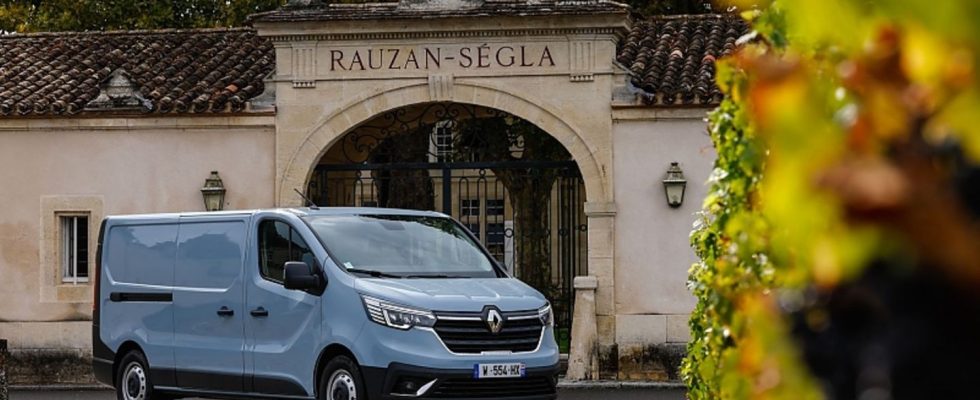Driving report: Renault Trafic E-Tech Electric L2H1 panel van
No restrictions
Renault Trafic E-Tech Electric panel van
© press-inform – the press office
Renault continues to energize its boiler suits. The Trafic E-Tech Electric impresses as a panel van L2H1 with its practicality and low consumption.
We already missed it. Now it’s back. The green leaf. There it is again, in the middle of the digital instrument display Renault Trafic E-Tech Electric and signals as soon as you are traveling ecologically. How often this virtual seal of efficiency will appear in the tough everyday work of a tradesman remains to be seen. What is crucial is that the electrified boiler suit transporter meets the variable requirements of the industry. This is even more important with the Renault Trafic E-Tech Electric, as the utility truck is a representative of the BEV medium van segment, which grew by 56 percent across Europe last year.
At first glance, the Renault Trafic E-Tech Electric with an output of 90 kW / 122 hp is not exactly generously motorized for such a van. But every thoroughbred trucker knows that torque and displacement are almost even more important for relaxed driving. So the power in Eco driving mode shrinks to 60 kW / 82 hp, but the 245 Newton meters of torque remains. That’s why you can get along confidently and easily with Eco in the city and on federal and country roads. Unlike its little brother Kangoo E-Tech Electric, you can neither switch off nor vary the recuperation on the Stromer-Trafic, which you can feel at slower speeds. From an energy perspective, we prefer pure sailing because energy recovery always involves losses and the driver should always keep the deceleration scepter in his hand or foot.
The result is a consumption of 22.2 kWh/100 km. During our test drive we achieved 19.0 kWh/100 km. That’s a decent value since we were traveling with a load of 300 kilograms. The chassis is far from reaching its limits with this extra load. What is completely missing is a camera that projects the image onto a monitor that acts as a rearview mirror. When we routinely check traffic, we look at a dark gray piece of hard plastic and increasingly use the side mirrors, which do not cover the usual rear area. A reversing camera and all-round sensors help with maneuvering.
Renault specifies the range of the Trafic E-Tech Electric, which is equipped with a 52-kilowatt-hour battery (comes from the Zoe and the electric Master), as a maximum of 297 kilometers. This makes this van more suitable for urban areas and less suitable for long distances. For those who still need to cover more distance, the French manufacturer will soon be introducing a long-range version of the electric utility truck that can travel up to 322 WLTP kilometers on a single battery charge. However, the top speed is then reduced to 90 km/h.
That brings us to charging, which in this scenario is likely to take place often during the night at the operator’s depot. The standard equipment with the 11 kW onboard charger is sufficient for this, with which the energy storage unit is filled from ten to 100 percent with 16 amps in 5:42 hours. If you tick the 22 kW onboard charger in the equipment list, 15 to 80 percent are completed in 1:24 hours at 32 amps. This additional package includes a heat pump that improves efficiency. Since the logistics industry calculates to the nearest cent, customers will make ordering this option dependent on the application scenario. Most people will stick with the basic version, which is completely sufficient. Later in the year, Renault will also offer a 50 kW DC variant. This recharging process can then be completed in an hour.
That would mean the driving is over; with a transporter like the Trafic, practicality is at least as important. The best efficiency is wasted if the vehicle proves to be impractical in everyday life. In this case, the incentive to buy the e-version would be significantly lower. The Renault managers emphasize that it has almost no restrictions compared to the combustion engine. The L2H1 version (5.48 meters long and 1.97 meters high) has a maximum capacity of 6.7 cubic meters. With the two sliding doors and the wide-opening butterfly doors, which can be unhooked with a flick of the wrist so that they fold completely to the side, the E-Trafic does not fall behind in this important value in the Blaumann rankings. However, we would have appreciated handles on the passenger side to make getting in easier. With a weight of 1,885 kilograms, you can pack up to 1,185 kilograms of payload into the cargo space. So the Stromer-Trafic is a real alternative to the classic van. For comparison: the version with a combustion engine is 66 kilograms more.
Only the L2 versions will be available for the launch of the Renault Trafic E-Tech Electric this autumn. The L1 variants of the van will arrive at the end of the year. The French are still keeping quiet about the prices for the L2 models. The only thing that is certain is that the L1H1 variant will cost 47,800 euros plus VAT. Here, too, it is worth taking a look at the price list: The Renault Trafic panel van L1H1 (3.0t) costs 33,080 euros excluding VAT as the Blue dCi 130 in the second “Basic” equipment variant.

